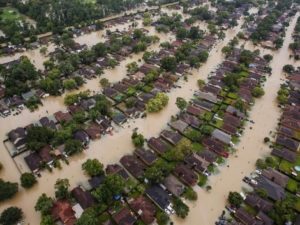Economic Impact of Hurricane Harvey and Irma
September 2017For the first time in recorded history, the U.S. was slammed by two Category 4 hurricanes from the Atlantic within the same year, devastating parts of Texas and Florida.
Hurricane Harvey made landfall on August 25, 2017, near the Texas Gulf Coast and stalling after landfall dumped a record 27 trillion gallons of rain on Texas and Louisiana in 6 days causing mass evacuations and catastrophic flooding along the gulf coast.
Only a mere 16 days later, on September 10, 2017, Florida was hit by Hurricane Irma. Yet another record-breaking storm that measured nearly 400 miles across made landfall in the Florida Keys before traveling up the spine of Florida.
Both of these storms have had disastrous impacts on affected areas causing extensive property damage and high loss output on economic activity for the two regions. According to a preliminary estimate from Moody’s Analytics, the two hurricanes have caused between $150 billion and $200 billion in damage to homes and furnishings, vehicles, commercial real estate, and public infrastructure.

Extensive flooding caused by Hurricane Irma
With Texas and Florida being the 2nd and 4th largest economies in the U.S., respectively, economist are slashing their estimates for third-quarter GDP growth. Goldman Sachs estimates GDP will increase by just 2% this quarter after cutting its estimates by 0.8%. The economic costs include disruptions to businesses, increased rates of unemployment, damage to infrastructure, crop losses, property damage and higher fuel prices.
However, many economists are predicting a robust fourth-quarter GDP due to rebuilding the affected areas; although estimates on the impact have not been released. “Any lost output and employment are likely to be made up in subsequent quarters,” said Gus Faucher, a senior vice president and chief economist at The PNC Financial Services Group.
“Reconstruction in the wake of Irma, funded by insurance payouts and federal aid, will boost the state’s economy and hiring in late 2017 and early 2018. Similar patterns have been seen with other natural disasters, such as Superstorm Sandy, Hurricane Andrew, and the Northridge earthquake,” said Faucher.
As Texas and Florida get back to work and start rebuilding following the devastation of Category 4 hurricanes, long-term outlooks are very optimistic and the current U.S. economic expansion, now in its ninth year, will continue.
Lastly, all of us here at Synergy Thermal Foils weathered the storm very well. We lost a few large trees and a couple days without power, our damage was very minor. We are back to operating under normal business conditions.